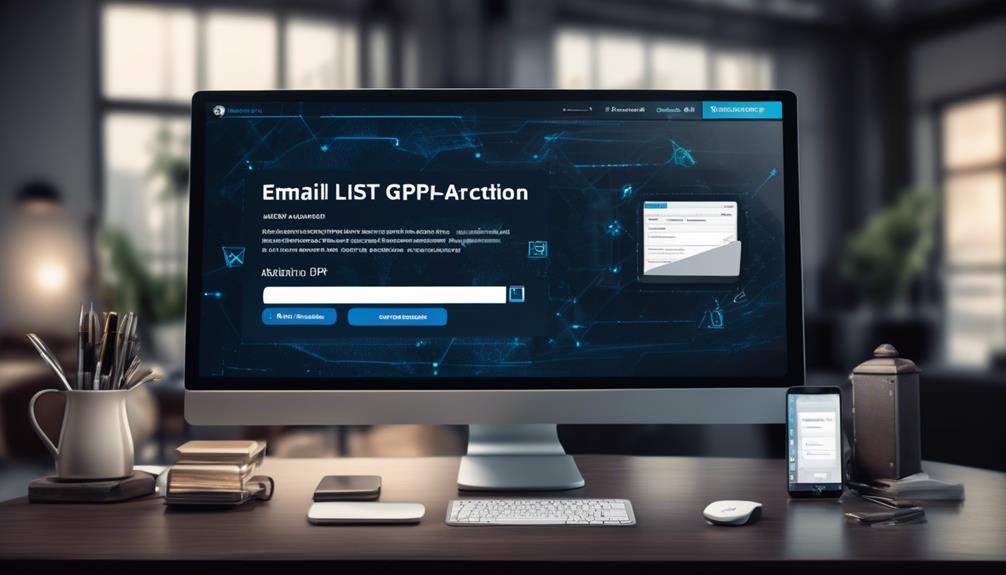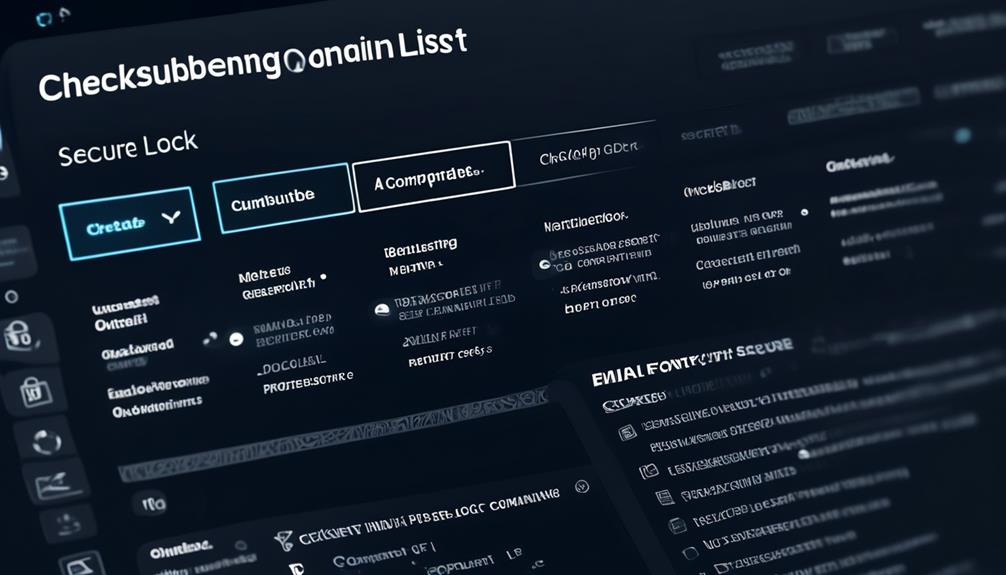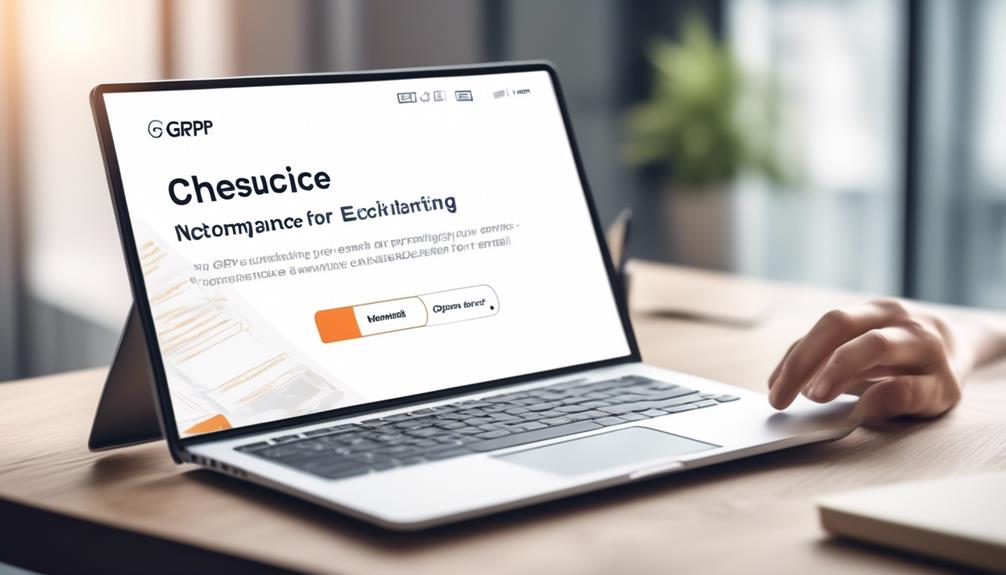Navigating the intricacies of GDPR compliance for email lists is like navigating a maze, with potential legal repercussions for mistakes. It is crucial for organizations to understand the specific steps required to ensure email lists are in compliance with GDPR regulations.
From obtaining clear consent to implementing robust security measures, each step plays a crucial role in safeguarding personal data and upholding privacy regulations.
As we delve into the 7 essential steps, you'll gain valuable insights into how to navigate the GDPR landscape and protect your organization from potential liabilities.
Key Takeaways
- Identify the sources, storage, and access of collected data
- Implement data access control measures
- Obtain clear, explicit, and informed consent before processing personal data
- Implement strong password policies to enhance website security.
Understand Data Collection
To effectively comply with GDPR regulations, we need to thoroughly understand the sources, storage, and access of the data we collect. This involves identifying where our data comes from, how it's stored, and who's access to it. For our email marketing efforts, this means being aware of the various touchpoints where personal data is gathered, whether it's through website sign-ups, event registrations, or other interactions.
Understanding the data collection process is crucial for GDPR compliance as it allows us to determine the legality and fairness of our practices.
Additionally, we must ascertain if sensitive personal data is being collected. This includes information such as religious beliefs, health data, or biometric data, which requires a higher level of protection under the GDPR. It's imperative to assess the level of protection needed for such data and ensure that our marketing activities align with the privacy requirements outlined in the Regulation.
Control Data Flow

As we discuss the subtopic of 'Control Data Flow', it's crucial to consider data access control, consent management, and privacy policy compliance.
By identifying data sources, storage, and access, we can ensure GDPR compliance and determine the involvement of sensitive personal data.
It's essential to implement a double-check system for email list sign-ups, use strong passwords with encryption measures, and utilize a secure and encrypted email service provider with policies to protect personal data.
Data Access Control
We prioritize implementing robust access controls to restrict and monitor access to email lists and subscriber information, ensuring compliance with GDPR regulations and safeguarding data integrity and confidentiality.
To achieve this, we:
- Use encryption and pseudonymization techniques to protect the confidentiality and integrity of email list data, in line with GDPR compliance requirements.
- Regularly review and update access control measures to align with GDPR requirements and best practices, considering the rights of the data subject and our privacy policy.
- Implement role-based access controls to ensure that only authorized individuals can access specific data within the email list, adhering to the principle of legitimate interest and our retention strategy.
Consent Management
Ensuring data integrity and confidentiality through robust access controls, we now pivot to discussing the implementation of a consent management system to control the flow of data and uphold compliance with GDPR regulations.
It's crucial to obtain clear, explicit, and informed consent from individuals before processing their personal data, especially when it comes to building an email list for email marketing. This consent must be freely given, specific, and unambiguous, and individuals should have the ability to easily withdraw their consent if they choose to do so.
Maintaining documentary evidence of consent is essential, and organizations should regularly review and update their consent management practices to ensure compliance with GDPR requirements. Seeking legal advice can further ensure that consent management processes align with the organization's unique situation and data privacy regulations.
Privacy Policy Compliance
To ensure compliance with GDPR regulations and control the flow of data, our organization implements stringent privacy policies that govern the management and usage of personal information.
- Implement a double-check system for email list sign-ups to ensure proper consent and permission. This involves obtaining explicit consent from individuals before sending marketing emails and ensuring that existing contacts have provided authorization to receive personalized and targeted communications.
- Use a web application firewall and encryption to protect personal data and comply with GDPR data security requirements. Additionally, clearly explain cookie data usage and obtain consent from visitors through a GDPR-compliant cookie banner.
- Maintain an accurate and relevant list of subscribers, including removing unsubscribed contacts and ensuring compliance with data subject rights. This includes incorporating an easily accessible email unsubscription process and including an unsubscribe link in all marketing communications.
Implement Two-Factor Authentication

We must recognize the importance of implementing Two-Factor Authentication to ensure secure access to email lists.
By requiring a second form of verification, we're able to verify the identity of users and add an extra layer of protection against unauthorized access.
This not only helps in complying with GDPR regulations, but also demonstrates our commitment to safeguarding sensitive data.
Secure Login Process
Deploying two-factor authentication significantly bolsters the security of the login process, effectively safeguarding sensitive data and aligning with GDPR guidelines. When implementing two-factor authentication for secure login processes in email marketing, it's crucial to:
- Require users to provide two forms of identification, such as a password and a unique code sent to their mobile device, to access their accounts.
- Prevent unauthorized access and protect personal information by adding an extra layer of security.
- Ensure compliance with GDPR requirements for securing data and gaining consent from EU citizens.
Implementing two-factor authentication not only enhances data protection but also builds trust with subscribers by demonstrating a commitment to their privacy and security. This, in turn, can reduce the risk of individuals unsubscribing from email lists.
Verify User Identity
Implementing Two-Factor Authentication (2FA) is a crucial step in verifying user identity and enhancing email security. It adds an extra layer of protection by requiring users to provide two forms of identification before accessing their accounts. This can include a combination of something the user knows (password), something they have (mobile device), or something they are (biometric data).
By implementing 2FA, organizations can mitigate the risk of unauthorized access and enhance compliance with GDPR data protection requirements. Additionally, 2FA can help organizations demonstrate a commitment to safeguarding personal data and reduce the likelihood of data breaches related to email accounts.
Ensuring the security of subscriber data is paramount in email marketing. Implementing 2FA not only aligns with legal advice on data protection but also strengthens consent and double opt-in processes. Ultimately, this contributes to GDPR compliance.
Prioritize Website Security

Utilizing SSL certificates to secure website traffic and implementing strong password policies are essential measures to prioritize website security in compliance with GDPR requirements for maintaining GDPR-compliant email lists.
Here are three crucial steps to enhance website security and ensure GDPR compliance:
- Regular Security Updates: It's imperative to regularly update and strengthen website security measures to protect against potential cyber threats and data breaches. This proactive approach helps in addressing any vulnerabilities and ensuring the security of user data.
- SSL Certificates and Data Encryption: Utilize SSL certificates to secure website traffic and ensure data encryption for sensitive information. This not only safeguards user data but also aligns with GDPR's emphasis on data protection and security.
- Strong Password Policies: Implement strong password policies and consider the use of password managers to enhance website security. Complex passwords and secure storage mechanisms are vital in preventing unauthorized access to personal data, aligning with GDPR's focus on data protection.
Clarify Motive

To ensure GDPR compliance, it's crucial to clearly articulate the motive behind collecting and using personal data in email lists, obtaining explicit consent from subscribers, and maintaining transparency regarding the processing and use of the collected data for email marketing purposes.
When communicating with subscribers, it's essential to clearly outline the value proposition and benefits they'll receive from being on the email list. This transparency not only helps in obtaining explicit consent but also builds trust with subscribers.
Furthermore, it's important to regularly review and update the motive and purpose of data collection to align with GDPR requirements and maintain compliance. By doing so, we ensure that the processing and use of personal data for email marketing are always in line with legal compliance.
Additionally, maintaining an audit trail of subscriber consent and regularly reviewing the purpose of data collection ensures that we can comply with requests such as the right to be forgotten.
Ultimately, clarifying the motive behind collecting and using personal data in email lists is crucial for building a strong and compliant email marketing strategy under the GDPR.
Add Cookie Notices

When ensuring compliance with GDPR regulations, it's essential to incorporate cookie notices on your website to inform users about the use of cookies and obtain their consent. This serves as a crucial step in maintaining GDPR-compliant email lists and ensuring data protection for your users.
To effectively add cookie notices, consider the following:
- Clearly explain cookie data usage: Provide a comprehensive explanation of how cookies are utilized on your website, including the types of data collected and the purposes for which it's used. Transparency is key to obtaining informed consent from users.
- Offer options for user preferences: Ensure that your cookie notices provide users with the ability to accept, reject, or customize their cookie preferences. This allows individuals to have control over the data collection process, aligning with GDPR principles of user consent and data protection.
- Enable consent revocation: Implement measures to allow users to revoke their consent for cookie usage at any time. This could include providing an easily accessible method for users to manage their cookie preferences or unsubscribe from certain types of cookies.
Assess Third-Party Risks

We must carefully evaluate the security measures and data protection practices of third-party email service providers to ensure their compliance with GDPR regulations and mitigate risks associated with their use. When assessing third-party risks for GDPR-compliant email marketing, it's crucial to consider the level of compliance of these third parties with GDPR regulations, including consent management and data subject rights. To assist in this evaluation, we have developed a framework to assess and mitigate the risks associated with third-party data processing and storage.
| Third-Party Assessment Criteria | Description |
|---|---|
| GDPR Compliance | Evaluate the third-party's adherence to GDPR regulations, including consent management and data subject rights. |
| Data Security Measures | Assess the security protocols and measures in place to protect the data processed and stored by the third-party. |
| Privacy Practices | Examine the third-party's data protection practices and their alignment with GDPR requirements for data protection and privacy. |
| Risk Mitigation Plan | Develop a plan to mitigate the potential risks associated with using third-party mailing list management services. |
Frequently Asked Questions
How Do I Become Gdpr-Compliant for Emails?
We ensure GDPR compliance for emails by:
- Obtaining clear consent from recipients
- Providing easily accessible opt-out options
- Securely storing and processing personal data
We regularly update and maintain our email lists, ensuring accuracy and relevance.
Our team stays informed about GDPR regulations and implements necessary changes to our practices.
We prioritize transparency and accountability, keeping detailed records of consent and processing activities.
Compliance is an ongoing commitment, and we continuously monitor and adapt to changes in regulations.
What Are the Requirements for Email Retention Under Gdpr?
We must retain email data under GDPR with lawful grounds, such as consent or legal obligation. Transparency and accountability are crucial, so we document the purpose and retention period for each category of emails.
Regularly review and delete outdated or unnecessary emails. Implement security measures to protect the stored email data. Additionally, consider anonymizing or pseudonymizing personal data to minimize risks.
Adhering to these requirements ensures compliance with GDPR's email retention regulations.
Does GDPR Apply to Email Marketing?
Yes, GDPR applies to email marketing.
We must ensure that all email marketing activities comply with GDPR regulations.
This includes obtaining explicit consent, providing proof of consent storage, and offering a method for individuals to request removal of their personal information from our email lists.
It's crucial to understand and adhere to these requirements to maintain GDPR compliance and build trust with our audience.
Are Email Addresses Covered by Gdpr?
Yes, email addresses are covered by GDPR. We must obtain explicit consent before collecting and using them. Our email marketing practices need to comply with GDPR, including obtaining clear consent, providing easy opt-out options, and transparently disclosing data usage.
Regular review and updates of our email lists are necessary for compliance. Seeking legal advice is advisable to align our practices with GDPR standards.
What Are the Essential Steps to Ensure GDPR Compliance for Email Lists?
To ensure the best practices for GDPR-compliant email lists, start by obtaining clear consent from subscribers. Keep records of when and how consent was given. Regularly update and clean your email lists to remove inactive or unsubscribed users. Lastly, ensure that all email communications include an option to unsubscribe.
Conclusion
In conclusion, ensuring GDPR-compliant email lists is crucial for protecting personal data and maintaining trust with our audience. By following the 7 steps outlined, we can navigate the complexities of data protection and continue to prioritize the privacy of individuals.
Just like a well-oiled machine, our compliance efforts will keep our email lists running smoothly and securely, providing peace of mind for both our organization and our subscribers.










